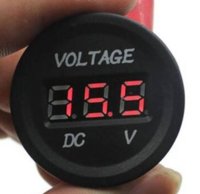I followed the guide and found a few things. Let me know if this shows the source of the problem.
When idling, V goes up to 12.3 then back down and up inconsistently, doesn't go up past that mostly stays around 12
Slap test is very weak with the case on. I took off the case and found this circle which seems to be the only part of the rotor
that is magnetized.
View attachment 122904
I unplugged the stator connector and none of the male ends make a connection when touching 2 of the 3 ends with a multimeter.
On the female side, only the bottom receptor makes a circuit with the + battery terminal.
Tested the regulator connector and that is fine. Tried revving while the regulator is bypassed to ground and no difference.
Another thing is I cant get a read on the rotor, seems like the rotor is no good.
Hi raimi,
that little round copper disc is the permanent magnet that triggers the ignition.
The rotor is an electromagnet that is only magnetized when the ignition is turned on and feeds it 12V DC from the battery.
Once you can get at both slip-rings you should see at least 4 Ohms resistance between them and no current at all between
either ring and the rest of the rotor.

